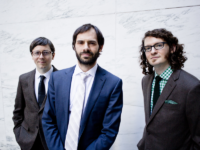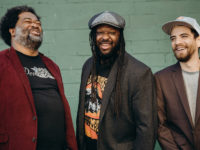feature photo: Ernest Stuart
When aberrant trombonist Jacob Garchik set out to make a gospel-themed jazz album in 2012 (The Heavens: The Atheist Gospel Trombone Album), he loaded up his ensemble with other trombonists and left out the rhythm section. When Garchik ventured to create an experimental, thrash-jazz record Ye Olde (2015) about a medieval battles in the Flatbush part of Brooklyn, he loaded up his ensemble with electric guitarists.
Delayed a bit by a pandemic, Garchik’s latest endeavor Assembly is your basic jazz quintet with Garchik joined by a sax player (Sam Newsome), pianist (Jacob Sacks), bassist (Thomas Morgan) and drums (Dan Weiss). You would think that this nonconformist composer and bandleader has gone “straight” and you would be wrong. Listening to Assembly and it becomes clear: not everything is what it seems at first blush.
For instance, the busy swing of “Collage” gets punctuated with unexpected blasts of a much slower, lofty figure. It soon becomes noticeable that the two opposing forces are the same band recorded over itself.
How this came about is the crux of the whole Assembly album: Jacob Garchik jammed with Morgan, Newsome, Sacks and Weiss, then he spent several months formulating defined compositions from the recordings of these jams, rearranging, adding, subtracting and reordering the raw ideas. Lastly, he presented these scripts to the same band, sometimes playing alongside the earlier recordings.
This is what is called a studio creation, which goes against the method by which jazz is traditionally recorded, but its approach isn’t too far removed from the fusion jazz studio experimentations undertaken by Miles Davis and his producer Teo Macero during the late 60s and early 70s. Garchik takes it further, however, in bringing the players back in after he’s built upon their initial improvisations and fragments. It makes for some truly exotic, sometimes incongruently fun alchemy.
“Fanfare” is a juxtaposition of Duke Ellington’s “In a Sentimental Mood,” rudely interrupted by Garchik’s interlocking, frantically ascending progressions. Clever looping of a circular Sacks solo forms the basis for “Idée Fixe,” inspiring complementing parts from Garchik, Newsome and Weiss. Newsome’s straight horn dances around Morgan’s simple bass figures very loosely during “Bricolage,” with barely participation from anyone else.
“Pastiche” is bracketed by retro-modern bop like something who might hear from Lee Konitz and Warne March with a Lenny Tristano-written tune, and Garchik, Newsome and Sacks are so tightly bound on the unison lines, it almost sounds like a single instrument, not three (the ending portion is nearly faster than what’s humanly possible). But the middle part is a blues jam reduced down to essentially a trio led by Garchik laying down licks in a distinctive voice.
The studio touch feels heavier on “Homage,” a dirge where everyone — including the rhythm section — are dubbed over each other, even the horn players are improvising alongside each other. On the extemporaneous number “Impromptu,” only Garchik and Newsome are performing, but as on “Homage,” they are tactfully recorded over themselves.
On “Fantasia,” that creepy, low-end gargle is Newsome’s sax played through a plastic hose attached to the neck. Although like other tracks, the song segues into the more conventional swing of the earlier session, more of the trickery intrudes, with multitracked piano tracks also spoiling the ‘ordinary’ jazz.
Living up to its name, Jacob Garchik’s Assembly puts together improvised parts to create structured pieces, only to place it back against its loose origins. It elicits a “what was that??” reaction, quickly followed by a “that was cool!” reaction.
Assembly releases on May 13, 2022 from Yestereve Records. Order it via Bandcamp.
- Ches Smith Quartet – ‘Clone Row’ (2025) - May 30, 2025
- James Brandon Lewis Quartet – ‘Abstraction Is Deliverance’ (2025) - May 27, 2025
- Soft Machine – ‘Drop’ (1971, 2025 remaster) - May 21, 2025




